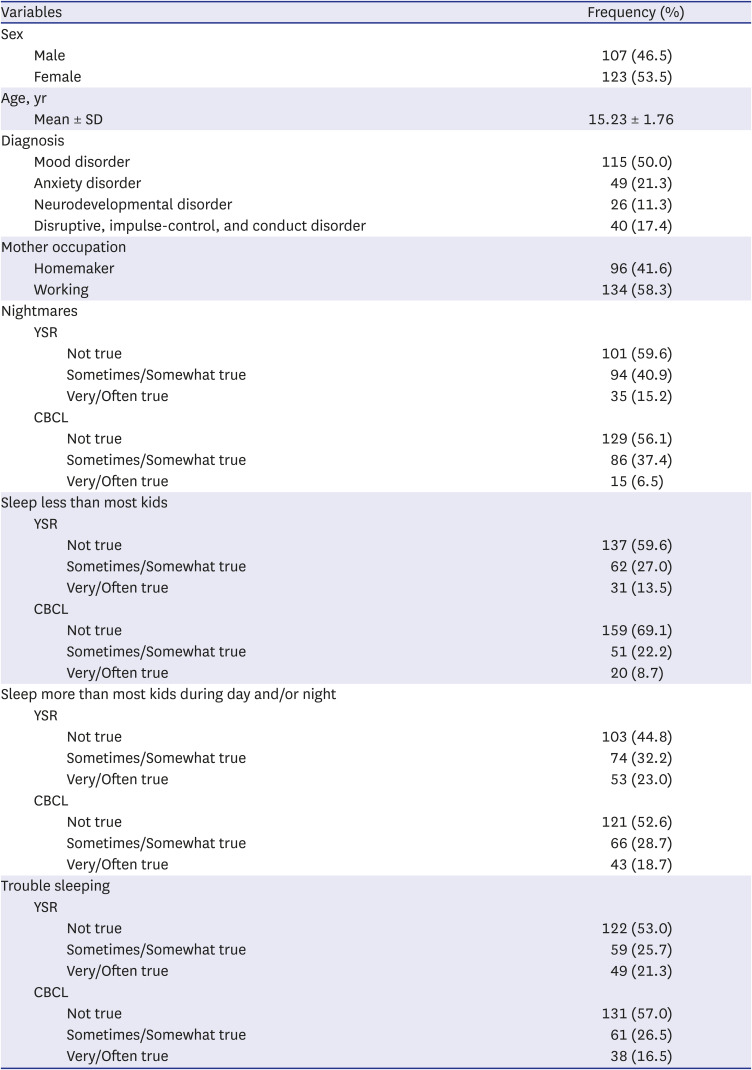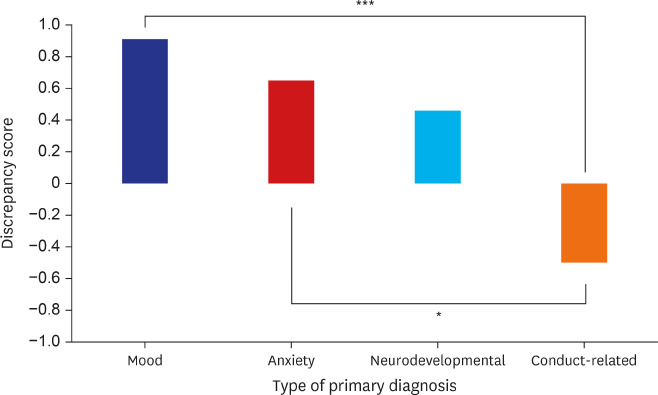1. Blader JC, Koplewicz HS, Abikoff H, Foley C. Sleep problems of elementary school children. A community survey. Arch Pediatr Adolesc Med. 1997; 151(5):473–480. PMID:
9158439.
2. Fricke-Oerkermann L, Plück J, Schredl M, Heinz K, Mitschke A, Wiater A, et al. Prevalence and course of sleep problems in childhood. Sleep. 2007; 30(10):1371–1377. PMID:
17969471.
3. Beebe DW. Cognitive, behavioral, and functional consequences of inadequate sleep in children and adolescents. Pediatr Clin North Am. 2011; 58(3):649–665. PMID:
21600347.
4. Yoo MA, Kang NG, Lee HJ. Relationships between sleep habits, daytime sleepiness and problem behaviors among adolescents. J Digit Converg. 2017; 15(5):305–315.
5. Kim SJ. A study of the association between sleep habits and cognitive, emotional, behavioral outcomes in preschool children. J Korean Counc Child Rights. 2015; 19(3):319–341.
6. Armstrong JM, Ruttle PL, Klein MH, Essex MJ, Benca RM. Associations of child insomnia, sleep movement, and their persistence with mental health symptoms in childhood and adolescence. Sleep (Basel). 2014; 37(5):901–909.
7. Fallone G, Owens JA, Deane J. Sleepiness in children and adolescents: clinical implications. Sleep Med Rev. 2002; 6(4):287–306. PMID:
12531133.
8. Sadeh A, Gruber R, Raviv A. Sleep, neurobehavioral functioning, and behavior problems in school-age children. Child Dev. 2002; 73(2):405–417. PMID:
11949899.
9. Chervin RD, Archbold KH, Panahi P, Pituch KJ. Sleep problems seldom addressed at two general pediatric clinics. Pediatrics. 2001; 107(6):1375–1380. PMID:
11389260.
10. Thome M, Skuladottir A. Changes in sleep problems, parents distress and impact of sleep problems from infancy to preschool age for referred and unreferred children. Scand J Caring Sci. 2005; 19(2):86–94. PMID:
15877633.
11. De Los Reyes A, Augenstein TM, Wang M, Thomas SA, Drabick DA, Burgers DE, et al. The validity of the multi-informant approach to assessing child and adolescent mental health. Psychol Bull. 2015; 141(4):858–900. PMID:
25915035.
12. Van Roy B, Groholt B, Heyerdahl S, Clench-Aas J. Understanding discrepancies in parent-child reporting of emotional and behavioural problems: effects of relational and socio-demographic factors. BMC Psychiatry. 2010; 10(1):56. PMID:
20637090.
13. Kim J, Chan YF, McCauley E, Stoep AV. Parent-child discrepancies in reporting of child depression in ethnic groups. J Nurse Pract. 2016; 12(6):374–380. PMID:
27672356.
14. Behrens B, Swetlitz C, Pine DS, Pagliaccio D. The Screen for Child Anxiety Related Emotional Disorders (SCARED): informant discrepancy, measurement invariance, and test-retest reliability. Child Psychiatry Hum Dev. 2019; 50(3):473–482. PMID:
30460424.
15. Makol BA, Polo AJ. Parent-child endorsement discrepancies among youth at chronic-risk for depression. J Abnorm Child Psychol. 2018; 46(5):1077–1088. PMID:
29124497.
16. Klaus NM, Mobilio A, King CA. Parent-adolescent agreement concerning adolescents’ suicidal thoughts and behaviors. J Clin Child Adolesc Psychol. 2009; 38(2):245–255. PMID:
19283602.
17. Treutler CM, Epkins CC. Are discrepancies among child, mother, and father reports on children’s behavior related to parents’ psychological symptoms and aspects of parent-child relationships? J Abnorm Child Psychol. 2003; 31(1):13–27. PMID:
12597696.
18. Combs D, Goodwin JL, Quan SF, Morgan WJ, Hsu CH, Edgin JO, et al. Mother knows best? Comparing child report and parent report of sleep parameters with polysomnography. J Clin Sleep Med. 2019; 15(1):111–117. PMID:
30621839.
19. American Psychiatric Association. Diagnostic and Statistical Manual of Mental Disorders: DSM-5. Arlington, VA, USA: American Psychiatric Association;2013.
20. Achenbach TM, Rescorla LA. Manual for the ASEBA School-Age Forms & Profiles. Burlington, VT, USA: University of Vermont, Research Center for Children, Youth & Families;2001.
21. Oh KJ, Kim YA, Ha EH, Lee HI, Hong KE. Child Behavior Checklist 6-18: CBCL 6-18. Seoul, Korea: HUNO;2010.
22. Thompson EC, Fox KA, Lapomardo A, Hunt JI, Wolff JC. Youth self report thought problems and sleep difficulties are linked to suicidal ideation among psychiatrically hospitalized adolescents. J Child Adolesc Psychopharmacol. 2020; 30(8):522–525. PMID:
32053009.
23. Kozak M, Piepho HP. What’s normal anyway? Residual plots are more telling than significance tests when checking ANOVA assumptions. J Agron Crop Sci. 2018; 204(1):86–98.
24. Kovacs M, Devlin B. Internalizing disorders in childhood. J Child Psychol Psychiatry. 1998; 39(1):47–63. PMID:
9534086.
25. Gomez R, Vance A, Gomez RM. Analysis of the convergent and discriminant validity of the CBCL, TRF, and YSR in a clinic-referred sample. J Abnorm Child Psychol. 2014; 42(8):1413–1425. PMID:
24824190.
26. Bajeux E, Klemanski DH, Husky M, Leray E, Chan Chee C, Shojaei T, et al. Factors associated with parent-child discrepancies in reports of mental health disorders in young children. Child Psychiatry Hum Dev. 2018; 49(6):1003–1010. PMID:
29869765.
27. Aronen ET, Lampenius T, Fontell T, Simola P. Sleep in children with disruptive behavioral disorders. Behav Sleep Med. 2014; 12(5):373–388. PMID:
24180372.
28. Chervin RD, Dillon JE, Archbold KH, Ruzicka DL. Conduct problems and symptoms of sleep disorders in children. J Am Acad Child Adolesc Psychiatry. 2003; 42(2):201–208. PMID:
12544180.
29. Kamphuis J, Meerlo P, Koolhaas JM, Lancel M. Poor sleep as a potential causal factor in aggression and violence. Sleep Med. 2012; 13(4):327–334. PMID:
22305407.
30. Bates JE, Viken RJ, Alexander DB, Beyers J, Stockton L. Sleep and adjustment in preschool children: sleep diary reports by mothers relate to behavior reports by teachers. Child Dev. 2002; 73(1):62–74. PMID:
14717244.
31. Chorney DB, Detweiler MF, Morris TL, Kuhn BR. The interplay of sleep disturbance, anxiety, and depression in children. J Pediatr Psychol. 2008; 33(4):339–348. PMID:
17991689.
32. Stores G. Multifactorial influences, including comorbidities, contributing to sleep disturbance in children with a neurodevelopmental disorder. CNS Neurosci Ther. 2016; 22(11):875–879. PMID:
27283112.
33. Yang CK, Hahn HM. Cosleeping in young Korean children. J Dev Behav Pediatr. 2002; 23(3):151–157. PMID:
12055497.
34. McStay RL, Dissanayake C, Scheeren A, Koot HM, Begeer S. Parenting stress and autism: the role of age, autism severity, quality of life and problem behaviour of children and adolescents with autism. Autism. 2014; 18(5):502–510. PMID:
24104515.
35. Lee JK, Chiang HM. Parenting stress in South Korean mothers of adolescent children with autism spectrum disorder. Int J Dev Disabil. 2017; 64(2):120–127. PMID:
34141299.
36. Almogbel YS, Goyal R, Sansgiry SS. Association between parenting stress and functional impairment among children diagnosed with neurodevelopmental disorders. Community Ment Health J. 2017; 53(4):405–414. PMID:
28176211.
37. Kroes G, Veerman JW, De Bruyn EE. Bias in parental reports? Maternal psychopathology and the reporting of problem behavior in clinic-referred children. Eur J Psychol Assess. 2003; 19(3):195–203.
38. Chandler S, Howlin P, Simonoff E, Kennedy J, Baird G. Comparison of parental estimate of developmental age with measured IQ in children with neurodevelopmental disorders. Child Care Health Dev. 2016; 42(4):486–493. PMID:
27126521.
39. Lerner MD, Calhoun CD, Mikami AY, De Los Reyes A. Understanding parent-child social informant discrepancy in youth with high functioning autism spectrum disorders. J Autism Dev Disord. 2012; 42(12):2680–2692. PMID:
22456819.
40. Willinger M, Ko CW, Hoffman HJ, Kessler RC, Corwin MJ. National Infant Sleep Position study. Trends in infant bed sharing in the United States, 1993-2000: the National Infant Sleep Position study. Arch Pediatr Adolesc Med. 2003; 157(1):43–49. PMID:
12517193.
41. Koh SK. Factors affecting children’s sleep duration and sleep time poverty. J Fam Resour Manage Policy Rev. 2017; 21(3):141–159.




